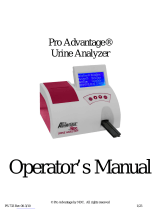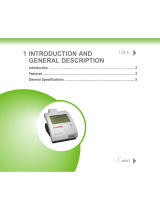
9
• The following is a list of error messages and suggestions on how to eliminate the problem:
Error Code Error Description Cause Action
E1 Reference pad error Gray reference pad on the test strip tray
soiled or damaged.
Switch off the instrument. If not visibly damaged, clean and
dry the pad. Insert the tray and wait for the self-check to
finish. If the error message reoccurs, call Roche Customer
Support Center.
E2 Wrong strip The test strip used is different from the
one for which the analyzer has been
programmed for (either Chem 10, Chem
5, or Chem 7). See Operator’s Manual.
Press the START button. Repeat the measurement using the
test strip that the instrument has been programmed for.
E3 Strip measurement a) No test strip present on the tray.
b) Test strip is incorrectly positioned on
the tray.
c) Urine on the test strip has dried.
d) Test strip has not been dipped in
urine.
Press the START button. Repeat the measurement with a
new test strip. Make sure the strip is inserted correctly and
that the retaining bar properly closes after the START but-
ton is pressed.
E4 Calibration Error Calibration values differ from those
obtained in the last valid calibration.
Press the START button. Repeat the calibration using a new
calibration strip. Make sure the calibration strip is properly
positioned under the clip on the test strip tray.
E5 Calibration Invalid Calibration values out of tolerance. Check the reference pad for soil or damage. Clean the ref-
erence pad or use the spare tray. Repeat the calibration
with a new calibration test strip. If the error reappears, call
Roche Customer Support Center.
E6 Chip Error The chip module underneath the printer
cover is missing, not making contact, or
is defective.
Switch off the analyzer, insert the chip module and switch
the instrument on again. If the error message appears
again, call Roche Customer Support Center.
E7 Missing Tray Test strip tray is missing or not inserted
far enough to engage the motor.
Insert the test strip tray correctly. (See Section 4 of Opera-
tor’s Manual.) Press the START button.
E8 Tray Position Error The positioning hole in the tray is dirty
or still wet after cleaning; the retaining
bar is open while the tray is advancing;
or the retaining bar mechanism is con-
taminated with urine and blocked.
Clean, blow through, or dry the positioning hole on the test
strip tray using a lint-free cloth. Remove any urinary depos-
its on both the top and bottom of the test strip tray. Insert
the tray again and press the START button. If the message
error persists, call Roche Customer Support Center.
E9 Wrong tray The test strip tray is not the one pro-
grammed for the analyzer or the gray
reference pad is missing from the tray.
Gray reference pad is scratched or dirty.
Press the START button. The strip type menu is displayed.
The strip type must match the tray type. (See Operator’s
Manual, Section 4.2.) Use the correct tray and make sure
the gray reference pad is clean. Press the START button.
E10 Light Barrier Error The light barrier used to control the
position of the test strip is defective or
the tray transport is blocked.
Pull out the tray and return it to the start position. Press the
START button. If the error message persists, call Roche
Customer Support Center.
E11 Motor Step Error The stepping motor drive is out of toler-
ance or the advance of the test strip
tray is blocked.
Carefully clean the tray. Clean and dry the positioning hole
using a lint-free cloth. Remove any urinary deposits on both
the top and bottom of the test strip tray. Insert the tray
again and press the START button. If the message error
persists, call Roche Customer Support Center.
E12 Optics Error The reference pad is missing from the
test strip tray or an LED or phototransis-
tor is defective.
Attach the reference pad. Press the START button. If the
error message appears again, call Roche Customer Support
Center.
E13 Printer Error Printer connection fault or paper jam.
This message will not appear if there is
no paper.
Switch off the analyzer. If there is a paper jam, clear it.
Switch the analyzer on again. If the error message appears
again, call Roche Customer Support Center.
























